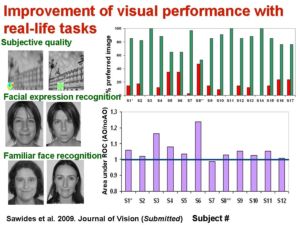Adaptive optics is a promising technology to assess the impact of optical aberrations on vision.
We have investigated the role of ocular aberrations on accommodation (Gambra et al 2009) -See crystalline lens: accommodation..."-
We have shown that correcting aberrations improves visual acuity in a large range of conditions (different luminances and contrast polarities). Visual acuity differs whether it is measured using black letters on white backgrounds or white letters on black background. The improvement of VA with AO-correction occurs systematically in all conditions except for the largest luminances with reversed polarity. Also, the largest the amount of corrected aberrations the largest the VA improvement (Marcos et al. 2008).

We are also interested in investigating the potential improvement of visual performance under real-life tasks. For this purpose, we tested the subjective impression of image quality (with and without correction of aberrations) using natural images, and found that most subjects found a clear improvement with correction. Additional tests included familiar face recognition (for which performance increased in most subjects with correction of aberrations) and facial expression recognition (which is not generally improved with correction). (Sawides et al. 2010).
New directions of research in our lab using adaptive optics include the evaluation of interactions of aberrations (optical and neural effects) and tests of neural adaptation.